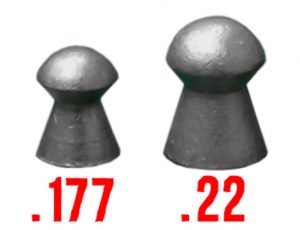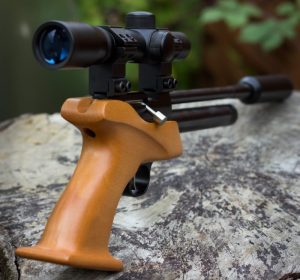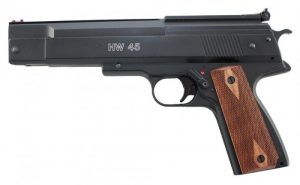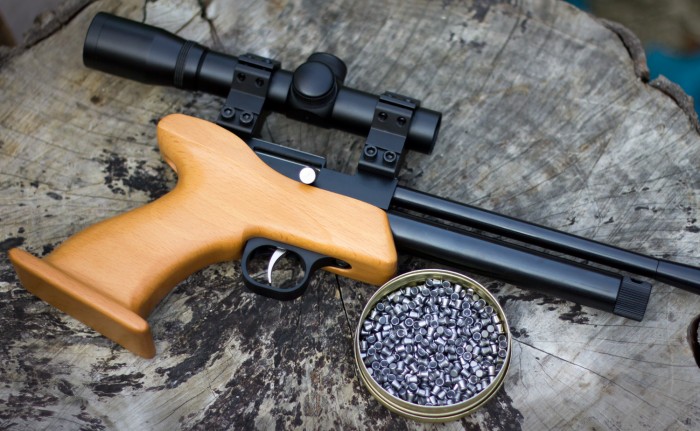Pistol Pest Control
There is no doubt that summer is prime season for pests but it is by no means the only time that pests are around so you need to be vigilant. Rats, unlike many other mammals, do not typically hibernate during winter and as the temperatures drop, they are more likely to be looking to move inside looking for warmth and shelter. This means that they will appear inside barns and garages where range is not so much a factor as manoeuvrability and ease of use.
When choosing a hunting pistol it is important to ensure that you have a pistol that shoots as close to the 6 ft/lb legal limit as possible. Careful consideration must be paid to ensure quick dispatching and the more powerful the gun, the more stopping power the pellet has. A 2-3 ft/lb 1911 is just not going to do the job humanely or otherwise.
There are two main airguns gun calibres .177 and .22. There are others but they are either too heavy for 6ft/lb guns and often more difficult to get hold of. So what is better .177 or .22? Sigh… this is an argument as old as time but here goes :

Well, .22 is often cited as the “hunting calibre” but, with the right shaped pellets, .177 can be just as effective. Due to power being worked out as a relationship between weight and speed the lighter pellets of the .177 calibre actually fly much faster than their heavier counterparts. This becomes an advantage as their trajectory is much flatter and therefore it is easier to be accurate. Hitting the head or vitals of a rat or small bird means shooting an area the size of a pound coin and so I actually prefer .177 for pistol pest control. As .177 pellets are travelling faster domed or pointed pellets have a habit of passing though the target which not only reduces lethality but can be problematic if shooting without a clear backstop. For this reason I would recommend flat head or hollow points for .177 and domed pellets for .22. That is my case for using .177 calibre anyway, but I have plenty of friends that swear by .22 especially for furry animals such as rats and rabbits which tend to be quite tough.
At the end of the day every hunter will tell you that accuracy is the most important factor when it comes to humane dispatching, you are often aiming for an area no larger than a pound coin so as long as you can reliably hit that, you will be fine. Just pick whichever calibre you prefer, it IS that simple. With that in mind, perhaps the most important aspect of pest control is practice, reliably hitting the same spot with a rifle is hard enough, but with a pistol it will require hours and hours of hard work until it is in your muscle memory. There are some people that will tell you that you hunting with an air pistol is inherently impossible to do humanely but I disagree, reliable expansion occurs at around 4ft/lbs, even less in hollow points, and a pellet that is fired from 6ft/lb air pistol will have this level of energy at ranges of around 15m.
Which Type of Air Pistol?
So you have your calibre, now what to choose, spring? CO2? Gas Ram? PCP? Single stroke? At least there was only 2 calibres to choose from…
Well, using my uncanny ability to treat my own opinions as fact, I’m going to trim the list down a bit. PCP pistols are undoubtedly effective but you are talking minimum 700 English pounds for a good one and that’s without factoring in the dive bottle and hose that you need to have one and that is probably too much money for a couple of rats so, unfortunately, they’re out.
Gas Ram pistols are essentially the same as spring pistols but use a non fatiguing piston system instead of a spring, sounds great right? Well, to my knowledge there are none close to the 6ft/lb limit that we are after so they are also out. Multi Stroke pistols suffer a similar fate with the majority of the models available being under powered with one exception. The Zoraki HP-01 has a variable power system which means that after 3 pumps the pistol will be powerful enough to be used for pest control. This means that having the pistol ready to shoot as by the time you have pumped the pistol up to full power, the rat or bird will likely be gone.
So that leaves us two viable options CO2 and spring power. As they are the most popular, let’s talk CO2 first.
CO2 pistols

There are a wide variety of CO2 powered pistols available that come in all shapes and sizes but for the majority, there are only a couple that are capable of killing. And the majority are based on one tried and tested design. The originator of the full powered air pistol is a model called the Crosman 2240 Buster which utilised an ingenious bolt action design that was powered by a single 12g CO2 capsule that produced around 5.5ft/lbs of muzzle energy. The 2240 stood as the undisputed king of the pest control world for a long time until a new design came along and took its crown.
The SMK CP1 has refined and ungraded the 2240s original blueprint and has become not just one of the best selling pest control pistols, but also one of the best selling airguns currently on the market. What makes it so effective is not just the power, but also the refinements made to the gun, the bolt has been moved to the left side to allow easier cocking, there is a chequered wood stock instead of the 2240s polymer and both the trigger unit and iron sights have received a significant upgrade. The CP1 also features a dovetail rail for the fitting of external optics and comes in a wide variety of calibres for maximum versatility, there is even a multi-shot version available. When looking for a pest dispatching pistol it is very hard to look past this model.
See more CO2 air pistols
Spring Powered Pistols
Spring powered pistols generally utilise a break barrel or lever system to fill a chamber with air and then release a spring which rapidly compresses the chamber forcing the pellet out of the barrel. The advantage of this design is that everything you need to fire is right there in your hands, no external gas canisters are required so if you can cock the gun, you can shoot it. This does also mean that unfortunately all spring pistols are single shot but with Gamo bringing out an ingenious multi shot spring rifle, the Maxxim Elite, I would imagine that a multi-shot spring pistol is not too far away.
Perhaps the most famous spring pistol is the XS26, one of the stalwarts of recent years that has continued to sell high numbers since its inception and has formed the basis of a lot of spring powered pistols that followed after it. Most notably was SMK’s own XS32 which not only upped the power slightly but improved the trigger system to make the gun more accurate and more reliable. The XS32 is equipped with fibre optic sights which is a plus as pests tend to be more active in low light, and is also surprisingly lightweight which not only reduces fatigue but also makes aiming easier, important when aiming for a small vital area.

Whilst the XS32 is a superb choice, the undisputed king of the spring powered pistol world is the Weihrauch HW45. Despite being several orders of magnitude more expensive than an XS32, particularly if you want the fantastic looking Silver Star model, this is the spring pistol I’d personally have. Of all of the names in the airgun industry, Weihrauch is probably the name you can most trust when it comes to delivering high quality construction and overall great performance. The HW45 is accurate to a tee and shoots a shade over 5 ft/lbs making it one of the most powerful spring pistols on the market and more than enough for a rat or pigeon at 10-15m. The pistol itself does require 13mm mounds to fit additional optics which is unusual but other than that I can’t fault it, one of the best pistols money can buy.
See more spring powered air pistols
So there you have it, a list of a selection of the pistols I would consider to be the best for pest control. If you are looking to purchase one be sure it’s here at Pellpax and stay tuned to the blog for all your airgun information.

